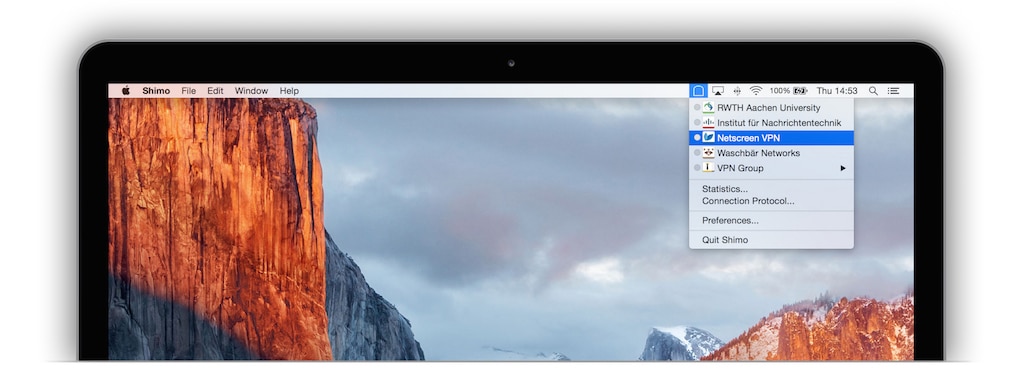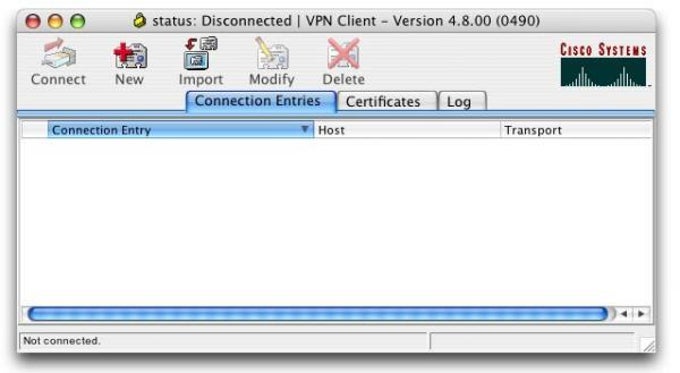So apparently QuickVPN is not available for Mac OS X, scuttling what is otherwise a great product for a mixed-platform small business. Can I ask someone from Cisco to advise on whether a Mac OS version of QuickVPN is planned?
Installing the VPN client software
1.- Download and unzip the file ClienteVPNMac.zip . This create a new vpnclient installer icon on the desktop. Double-click on the vpnclient installer icon.
2.- Will be create a vpnclient installer directory. This directory contains the installer package and any preconfigured files in the Profiles and Resources folders. Open the installer package by double-clicking on the 'Cisco VPN Client.mpkg' file that resides in the installer directory.
3.- The first window that appears during installation is the introduction. The right pane of the Introduction window lists system requirements. The left pane displays each of the installation steps. As you complete each step, it is highlighted with a blue bullet.
4.- You are required to read and accept the Cisco software license agreement before you can continue with the installation process. To continue with the installation, click Agree and then Continue.
5.- The next screen allows you to select the where you want to install the VPN client. Normally you should accept the default location and click Install to start the installation.
You'll probably be asked to enter your mac user password to confirm that you want to install the software. Enter it and click on OK.
6.- Once you do, the installation will start and you'll see the progress of the installation. If all is right, the installation will be success.
Click on Close to close the installation window.
The default installation process installs the VPN Client in the Applications directory.
Making the Cisco VPN Connection
1. First make sure that you have connected to the Internet as you usually do, using either your broadband connection or a dialup connection.
2. Go to your Applications folder and open the Cisco folder.
3. Click New to create a new connection entry.
4. A new dialog box titled VPN Client | Create New VPN Connection Entry appears. Enter configuration information for the new connection.
In the Connection Entry field, assign a name to the new entry that is created.
In the Host field, type 'vpn.upv.es' (without quotation marks) .
Select the Authentication tab, and then type the group name and password (twice - for confirmation).
The group name is 'soloupv' (without quotation marks) if you only want access to shared resources, or 'biblioteca' (without quotation marks) if you want access to the library's electronic journals.
For the password type 'upvnet' (without quotation marks).
Click Save to save the information entered. The new connection is now created.
5. In Transport tab check ‘Enable Transparent Tunneling’ y ‘IPSec over UDP (NAT/PAT)’
6. Save the data and verify that it has created a new entry in the application.
7. Select the new entry and click on Connect. After a couple of seconds you will then be prompted to fill in your username and password. ( Which is my username?)
8. If the connection is successful, you will see in this window saying ' Connected to 'VPN-UPV'. The yellow padlock indicates that the connection is established.
9. If you want to reconnect you can click on the 'Disconnect'
Objective
There is no Quick VPN version suitable for Mac OS. However, there is an increasing number of users who would like to deploy a Quick VPN alternative for Mac OS. In this article, IP Securitas is used as an alternative for a Quick VPN.
Note: You need to download and install the IP Securitas on your MAC OS before you start configuration. You can download it from the following link:
This article explains how to deploy a Quick VPN alternative for Mac OS on Rv016, RV042, RV042G and RV082 VPN Routers.
Applicable Devices
• RV016
• RV042
• RV042G
• RV082

Software Version
• v4.2.2.08
Deploy a Quick VPN Alternative for Mac OS
Note: The VPN Client to Gateway configuration of the device needs to be done first. To know more how to configure VPN Client to Gateway refer to Set Up a Remote Access Tunnel (Client to Gateway) for VPN Clients on RV016, RV042, RV042G and RV082 VPN Routers.
Step 1. Run the IP Securitas on the Mac OS. The IPSecuritas window appears:
Step 2. Click Start.
Step 3. From the menu bar, choose Connections > Edit Connections. The Connections window appears.
Step 4. Click the + icon to add a new connection.
Step 5. Enter a name for the new connection under connections.
General
Step 1. Click the General tab.
Step 2. Enter the IP address of the remote router in the Remote IPSec Device field.
Note: You do not need to configure Local Side as this configuration is for remote client. You just need to configure Remote Mode.
Step 3. In the Remote Side area, choose Network from the Endpoint Mode drop-down list.
Step 4. Enter the subnet mask in the Network Mask (CIDR) field.
Step 5. Enter the remote network address in the Network Address field.
Phase 1
Phase 1 is the simplex, logical security association (SA) between the two ends of the tunnel to support secure authenticated communication.

Step 1. Click the Phase 1 tab.
Step 2. Enter the lifetime you entered during the configuration of the tunnel in the Lifetime field. If time expires, a new key is renegotiated automatically. The key lifetime can range from 1081 to 86400 seconds. The default value for Phase 1 is 28800 seconds.
Step 3. Choose the appropriate time unit for the Lifetime from the Lifetime drop-down list. The default is seconds.
Step 4. Choose the same DH Group which you entered for the configuration of the tunnel from the DH Group drop-down list. The Diffie-Hellman (DH) group is used for key exchange.
Step 5. Choose the encryption type from the Encryption drop-down list which you entered for the configuration of the tunnel. The Encryption method determines the length of the key used to encrypt/decrypt Encapsulating Security Payload (ESP) packets.
Step 6. Choose the authentication method which you entered for the configuration of the tunnel from the Authentication drop-down list. The type of authentication determines the method to authenticate ESP packets.
Step 7. Choose the appropriate exchange mode from the Exchange Mode drop-down list.
• Main — Represents exchange mode for all type of gateway except Full Qualified Domain Name (FQDN).
• Aggressive — Represents the exchange mode for Full Qualified Domain Name (FQDN) gateway.
Phase 2
Phase 2 is the security association to determine the security of the data packet during the data packets pass through the two end points.
Step 1. Click the Phase 2 tab.
Step 2. Enter the same lifetime in the Lifetime field which you entered for the the configuration of the tunnel and also Phase 1.
Step 3. Choose the same time unit of the lifetime from the Lifetime drop-down list which you entered for the configuration of the tunnel and Phase 1.
Step 4. Choose the same DH group from the Perfect Forwarding Secrecy (PFS) Group drop-down list which you entered for the the configuration of the tunnel.
Step 5. Uncheck all the unused Encryption and Authentication methods. Only check the ones defined under the Phase 1 tab.
ID

Step 1. Click ID tab.
Step 2. Choose the same method of local identifier as the tunnel from the Local Identifier drop-down list. Enter the appropriate value according to the type of local identifier if needed.
Cisco Quickvpn Setup
Step 3. Choose the same method of remote identifier as the tunnel from the Remote Identifier drop-down list. Enter the appropriate value according to the type of remote identifier if needed.
Step 4. Choose the same authentication method as the tunnel from the Authentication Method drop-down list. Enter the appropriate authentication value according to the type of authentication method if needed.
Games Download For Mac
Step 5. Click the x icon (red circle) to close the connection window. This automatically saves the settings. The IPSecuritas window appears.
Linksys Quickvpn Client Download
Connection
Vlc Download For Mac
Step 1. In the IPSecuritas window, click Start. The user is then connected to access the VPN.